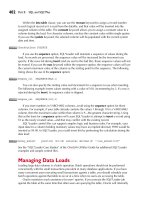42 TELESALES TIPS YOU CAN USE RIGHT NOW TO GET MORE BUSINESS AND AVOID REJECTION
Bạn đang xem bản rút gọn của tài liệu. Xem và tải ngay bản đầy đủ của tài liệu tại đây (141.09 KB, 14 trang )
42 TELESALES TIPS YOU
CAN U SE RIGHT NOW TO GET MORE BUSINESS AND
AVOID REJE CTION
By Art Sobczak
Telemarketing, telesales, cold calling ... whatever you want to call it (and I'll use the terms
interchangeably), the professional use of the phone in sales is a process, not a goofy
technique or gimmick.
We're going to travel through every part of the professional telesales- telemarketing call, in
order, discussing proven tips that can help you right now. Let's go!
PRE-CALL PLANNING
1. Have a primary objective for every telemarketing call, defined as, "What do I want them
to DO as a result of this call, and what do I want to do?"
2. Prepare questions for your telesales call using your call objective. Ask yourself, "How
can I persuade them to take this action as a result of asking questions, as opposed to
talking?" Remember, people believe more
of their ideas than yours.
3. Also have a secondary objective for each telephone sales call...something you'll strive to
accomplish, at minimum, every time. Pick something you'll have a reasonably good chance
to succeed with, such as, "Getting their
agreement they will accept my literature and place it in their 'Backup Vendor' file." This
way, you can enjoy success on every call you place, and that does wonders for your
attitude.
BEFORE REACHING THE DECISION MAKER
4. Treat the screener as you would the customer--this person determines whether or not
you'll even have a chance to speak with the buyer.
5. Gather as much information as you can from whomever you are able, prior to speaking
with your prospect; busy decision makers get bored when they have to answer your basic
qualifying questions. Use the "Help" technique: "I hope you can help me. So I'm better
prepared when I speak with Ms. Big, there's probably some information you could provide
me..."
6. Before cold calls, think of a good reason for needing to speak with the decision maker,
and be prepared to sell this to the screener. What they're thinking about you:
"Does this person have anything of interest, or of value for the boss?"
7. If leaving a message on voice mail, or with a screener, be certain it offers a hint of a
benefit/result that sparks curiosity, but doesn't
talk about products/services.
INTEREST-CREATING OPENING STATEMENTS
8. The objective of your telemarketing opening is to pique curiosity and interest so that
they will willingly and enthusiastically move to the questioning. You must answer, "What's
in it for me?" for the listener, or they will immediately begin the getting-rid-of-you process.
9. Don't use goofy, resistance inducing phrases on your telesales call, like, "If I could show
you a way to _____, you would, wouldn't you?" The only decision you're looking for in the
opening is the one to continue speaking
with you.
10. When cold call prospecting, don't start the call with, "I was just calling people in your
area..." People want to feel like they're the only person you're calling... not just one of the
masses from a list of compiled names.
11. Use what I call "weasel words" when opening cold prospecting calls: "depending on,"
"might," "maybe," "perhaps," and "possibly." These are non-threatening words that
intimate you might have something of value for them, but you really need to ask questions
first. For example, "Depending on what you're now doing in the area of employee benefits,
I might have something that could potentially increase the number of options you offer,
while possibly decreasing your overall contribution. I'd like to ask you a few questions to
see if this is something you'd like more information on."
12. Have something of value to say on every telemarketing call. Particularly those regular
calls to existing customers. Avoid, "Just checking in with you to see if you needed
anything," and, "Just calling to touch base." These are more nuisance than service. Be
certain they're able to say they are better off after your call than they were before it, even if
they didn't buy anything. Call with news they'll have an interest in; ideas you've heard from
other customers they might be able to take advantage of; mention that you were "thinking
of them" and tell them why. One of my printing salesmen called to say he "just came back
from a trade show and saw something interesting, and thought I could benefit from it." It's
little things like that, that cause customers to say, "She always has something good for me
when she calls," as opposed to, "Every time she calls she's just looking for an order."
(For more great ideas, including word-for-word examples, and a fill-in-the-blanks template
on creating your own effective opening, also see the Special Report on Developing Interest
Creating Opening Statements.)
EFFECTIVE QUESTIONING
13. Get information before you give it. How could you make an effective presentation
otherwise?
14. Don't use a "benefit list" to present from. Instead, use it to create questions to determine
if those "benefits" truly are of value to your prospects and customers. Some "benefits"
could actually be liabilities.
15. Avoid asking go-nowhere questions like, "Is everything going OK?", "What are your
needs?", "Are you having any problems now?", "How's service?", and, "What are you
looking for in a vendor?" These all force the person to think too much. Instead, get them
emotionally involved in seeing and feeling the pain or problem that can be solved with
your product/service-especially problems you know they're likely experiencing. For
example, "What do you do in situations when you need
parts shipped overnight, but are unable to get them?"
16. Ask one question at a time. That's how many they'll answer at a time.
17. After asking, be quiet. Resist the urge to jump in if they don't answer immediately.
Don't be intimidated by silence. They're likely thinking about what they're going to say.
18. After they've finished, count to two (silently, of course). This ensures they're done, plus
they might continue with even better information.
19. Be confident in your questioning. One reason reps ramble with questions is that they're
not prepared or confident. Prepare
your questions. Role play them-with yourself if necessary.
20. Always know where you'll go with answers. Regardless of the answer.
21. Follow up their answers with related questions. Too often reps work from a rigid list of
questions, losing the opportunity to pick up on prospect statements which are just the tip of
the iceberg of their real feelings. For example, if a prospect said, "I believe the main reason
production isn't higher is a lack of motivation. The best move is to follow up with, "I see.
What specific signs of poor motivation have you noticed?", or, simply, "Tell me more."
(For lots of other ideas on questioning, and all parts of the call, get How to Sell More, In
Less Time, With No Rejection, Using Common Sense Telephone Techniques, Volumes 1
and 2, www.BusinessByPhone.com/HSM.htm)
22. Quantify the problem whenever possible. "How often does that happen?" "How much
do you think that is costing you?" "How much
time does that take?"
23. Resist the tendency to present. Some reps get so excited when they hear the slightest
hint of an opportunity, that they turn on the spigot of benefits. Hold off, ask a few more
questions, get better information, and you're able to craft an even harder-hitting description
of benefits, tailored precisely to what they're interested in.
24. Learn more about the decision-making process. There could be many behind-the-scenes
influences on the decision. Ask about actual users of your products/services, anyone else
who could influence it, who
has to sign off on the ultimate decision or OK the money for it, and perhaps people who
would rather not see it happen.
SALES RECOMMENDATIONS
25. You should only talk about your product/service after knowing specifically how it will
solve the problem, meet their need, etc. Then you can tailor your remarks specifically and
personally for the listener.
26. Get feedback during your discussion of benefits: "Do you feel that would work for
you?". "How do you feel that would solve your problem?" Some trainers might tell you that
gives the prospect an opportunity to tell you "no." Precisely. And that's good. Because if
there's a problem, and they don't see enough value in what you've presented, now is the
time to find out.
27. Avoid the question, "Anything else?" when attempting to upsell. Just like when a
convenience store clerk asks the same question, the answer is usually, "No." Instead, give
them a suggestion, and help them answer. For example, after they agree to buy an item, or
a service, say, "Many of our customers who get _____ from us, also find that ____ is also
very beneficial for them. What are you now doing/using/buying in that area?"
GETTING COMMITMENT (Closing)
28.This is not the major event in a telemarketing sales call. It's the natural, logical,
validation of the professional sales process up to this point. But you still must ask.
Commitment must be gained on every contact in order to move the process forward. If
there is to be a follow-up contact, and information is to be sent or faxed, there must be
commitment on behalf of the prospect regarding that material.
29. Ask large. Think big. Buyers will often move down from a large recommendation, but
they rarely move up from a small one. Those who ask the biggest have the largest average
order size. Never suggest more than is in the best interest of the customer, but not making a
large enough suggestion when appropriate is actually hurting the customer.
30. When in doubt, ask. Do you have a foot-dragger in your follow-up file who is perched
squarely on the fence? Ask for a decision! Get some movement. A "no" today is better than
one six months and 15 additional calls from now. Move them forward, or move them out.
31. If you're going to schedule a follow up call, get a commitment of some type. Why
would you call back otherwise. If they won't commit to doing anything--reviewing your
literature and preparing questions, surveying their existing inventory, etc.-they likely have
no interest.
ADDRESSING RESISTANCE (Objections)
32. Objections can be avoided by doing everything else correctly up to this point in the call.
When they do occur, resist the tendency to attack in defense. You must back up and revisit
the questioning stage of the call. The voiced objection is simply a symptom of the real
problem. Start by saying, "Let's talk about that."
33. If you have an indecisive prospect, get their mind off the buying decision, and on the
problem or pain. For example, "Jan, let's look at this another way. What would happen if
you did nothing about the situation? Remember, we detailed the fact you're missing sales
opportunities every day. What will that amount to over just the next six months?"
34. Most price objections start in the mind of the salesperson. Many sales reps aren't 100%
sold on the value of their product, therefore they're apt to offer price concessions even
when the prospect doesn't flat-out ask, or they present price with a shaky tone of voice. Ask
the right questions, present the results of what your product/service can do, and state the









